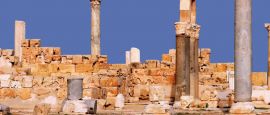Libya Weather, climate and geography
Weather & climate
Summers are very hot and dry; winters are mild with cooler evenings. The desert has hot days and cold nights. Spring and autumn are ideal times to visit, when the warm air comes up from the Sahara and meets a cooling breeze from the Mediterranean.
Libya is a huge country and weather patterns vary by region. The Mediterranean coastline is the focus of most travellers' trips to Libya. There, summers are hot and dry and winters are mild, although the evenings can be worthy of scarves and hats.You'll find similar, though slightly warmer conditions to those on the other side of the ocean, such as southern Italy and Greece. Libya's coastline can be very windy, so be sure to pack a headscarf (women should of course bring one anyway as this is a deeply conservative Muslim country) to protect your ears from being blasted by the breeze.
Rainfall is sporadic and rarely heavy, but drizzly days in autumn and winter are fairly common. Temperatures in Tripoli in January range from 7 to 17°C; in July, you can expect bright sunshine, blue skies and a mercury reading of between 20 and 25°C. In the winter of 2011/12, Libya's coastline had its first snowfall in decades. The desert has hot days and cold nights; the closer to the equator you travel, the hotter the days will be. With the exception of the far southern desert close to Libya's borders with Chad, southern Egypt and Sudan, humidity is generally low.
Loose, long clothes in natural fabrics are recommended. A cover-up for the cooler months is advisable. Warm clothing for nights in the desert. Modest dress is advised, especially for women - upper legs and arms, shoulders and cleavage should be covered. A headscarf can be useful as extra coverage, and is essential for visiting mosques, cemeteries or other sites that bear religious significance.
Geography
About 95% of Libya, Africa's fourth largest country, consists of desert (the Sahara). In the west the Sahara desert extends into Tunisia and Algeria, in the east into Egypt, and across the southern frontiers into Niger, Chad and Sudan. Only 20% of the desert features sand dunes - most of it consists of hamada (rock plateau) and, in the south, dramatic basalt mountains, the highest point of which is Bikubiti (2285m), near the Chad border. There are a few oases scattered throughout the country, mainly in the south.
There are almost 1,770 km (1,100 miles) of Mediterranean coast, with a low plain extending from the Tunisian border to the Jebel Akhdar (Green Mountain) area in the east. Inland the terrain becomes more hilly. Agriculture has developed mainly on the coast between Zuwarah and Misratah in the west and from Marsa Susa to Benghazi in the east. In the uplands of the old province of Cyrenaica and on Jebel Akhdar the vegetation is more lush.
Desertification is a huge problem, but the Great Manmade River Project, the largest water development scheme in the world, was built to bring water from large aquifers under the Sahara to the coastal cities. Gaddafi left the Great Manmade River Project unfinished, but there are plans to bring in new developers sometime in the future.
Do you have any Feedback about this page?
© 2025 Columbus Travel Media Ltd. All rights reserved. No part of this site may be reproduced without our written permission, click here for information on Columbus Content Solutions.




 You know where
You know where